Table of Contents
- Introduction
- Editor’s Choice
- Global Nursing Workforce Statistics
- Demographic Profile of Nurses
- Nursing Work Shifts Statistics
- Education Level of Nursing Workforce Statistics
- Nursing Workforce Salaries Statistics
- Nursing Workforce Pay Gap Statistics
- Private Nursing Workforce Industry Statistics
- Nursing Workforce Care Spending Statistics
- Key Nursing Workers’ Issues and Industry Trends
- Impact of COVID-19
- Regulations for Nursing Workforce Statistics
- Recent Developments
- Conclusion
- FAQs
Introduction
Nursing Workforce Statistics: The nursing workforce comprises various roles, including Registered Nurses (RNs), Nurse Practitioners (NPs), Licensed Practical Nurses (LPNs), and Nursing Assistants (CNAs), each with distinct responsibilities and educational requirements.
R.N.s, the largest group, typically hold an Associate or Bachelor’s degree and provide comprehensive patient care. N.P.s with advanced degrees offer specialized medical services and hospital services.
LPNs and CNAs support patient care under supervision, with LPNs requiring a diploma or certificate and CNAs needing state certification.
The nursing workforce, which exceeds 3 million in the U.S., faces challenges such as shortages and burnout. But also benefits from growth in advanced practice roles and diverse career opportunities.

Editor’s Choice
- As of 2021, the number of practicing nurses per 1,000 inhabitants varies significantly across different countries. Finland leads with 18.9 nurses per 1,000 inhabitants.
- The racial and ethnic distribution of registered nurses in the United States shows a significant majority of White nurses, who comprise 75.4% of the workforce.
- Among inpatient nurses, 17% work shifts of 12 or more hours, 51% work 12-hour shifts, 12% work 10-hour shifts, 19% work 8-hour shifts, and 1% work less than 8-hour shifts. With another 1% falling into the ‘Other’ category.
- The highest paying countries for nurses, based on average annual salary in USD. Reveal a range of lucrative opportunities across various regions. Luxembourg leads with an average salary of $97,857 per year.
- In 2013, the salary gap between male and female nurses in the U.S. varied significantly by job position, revealing notable disparities. Nurse anesthetists experienced the largest gap, with male nurses earning $17,290 more than their female counterparts.
- In 2023, registered nurses in the United States reported high levels of stress during their work. A significant 56% of respondents indicated experiencing a great deal of stress.
- To increase overall work satisfaction among nursing staff. 68% of respondents indicated that increasing salary, wages, or bonuses would be most effective. Nursing workers perceive various support initiatives as critical to their effectiveness and well-being.
- Among respondents, 68% rated more appropriate and sufficient recognition as important. With 28% viewing it as neutral and only 4% considering it not important.
Global Nursing Workforce Statistics
Nurse Density Worldwide – By Country
- As of 2021, the number of practicing nurses per 1,000 inhabitants varies significantly across different countries.
- Finland leads with 18.9 nurses per 1,000 inhabitants, followed closely by Switzerland and Norway, each with 18. Iceland has 15 nurses per 1,000 inhabitants, while Australia and Ireland each have 13.
- Japan, Germany, and the United States report 12.1, 12, and 12 nurses per 1,000 inhabitants, respectively.
- Luxembourg has 11.7, the Netherlands 11.4, Belgium 11.1, and New Zealand 10.9.
- Sweden, Austria, and Slovenia have 10.7, 10.6, and 10.5 nurses per 1,000 inhabitants, respectively. Canada and Denmark have 10.3 and 10.2, respectively.
- France reports 9.7 nurses per 1,000 inhabitants, while the OECD37 average stands at 9.2. The Czech Republic has 9, Korea 8.8, and the United Kingdom 8.7.
- Lithuania, Portugal, and Estonia have 7.9, 7.4, and 6.5 nurses per 1,000 inhabitants, respectively. Spain and Italy report 6.3 and 6.2, respectively, with the Slovak Republic and Poland each having 5.7.
- Israel and Hungary report 5.4 and 5.3, respectively, while Latvia and Bulgaria each have 4.2.
- Greece has 3.8, Chile 3.7, and Mexico 2.9 nurses per 1,000 inhabitants.
(Source: Statista)
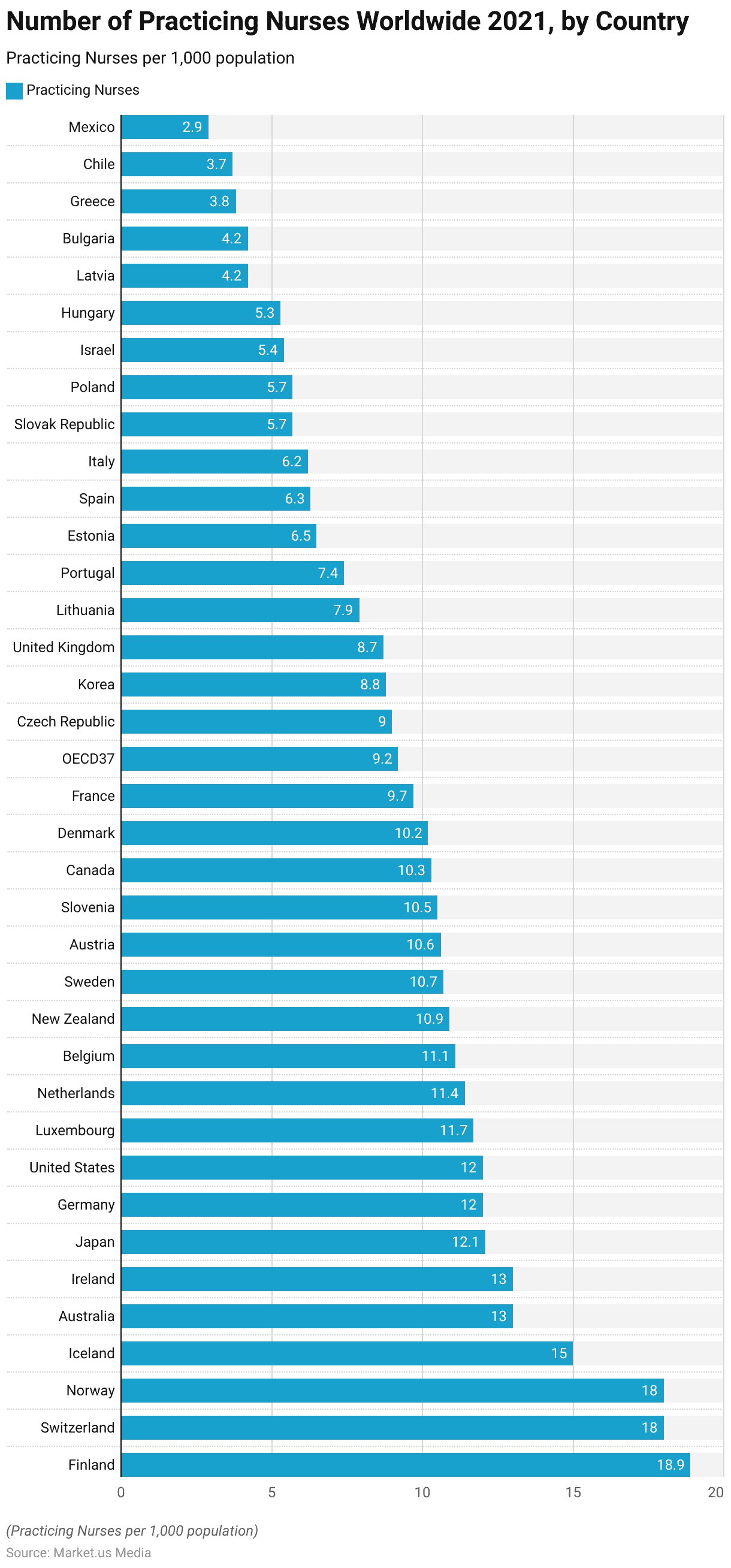
Nursing Workforce and Midwifery Personnel – By Region Statistics
- As of 2013, the density of nursing and midwifery personnel per 10,000 population varied significantly by region.
- Europe had the highest density, with 80.2 personnel per 10,000 population.
- The Americas followed with 44.9 personnel per 10,000 population.
- The global average stood at 28.6.
- In the Western Pacific region, the density was 26.2, while the Eastern Mediterranean region had 18 personnel per 10,000 population.
- Southeast Asia reported a density of 15.3, and Africa had the lowest density. With only 12.4 nursing and midwifery personnel per 10,000 population.
- This data underscores substantial regional disparities in the availability of nursing and midwifery services worldwide.
(Source: Statista)
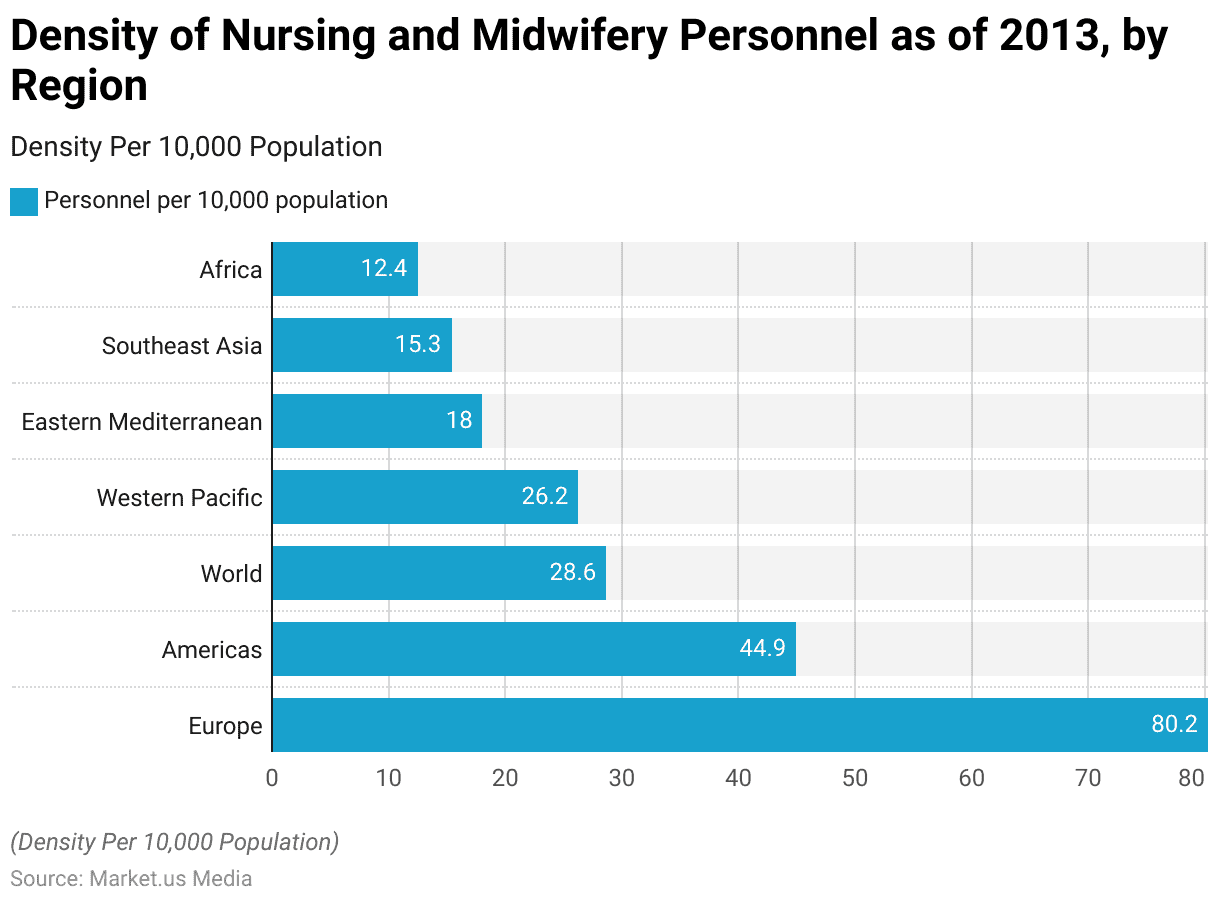
Registered Nursing Staff – By Field of Practice
- In 2023, the number of registered nursing staff in the United Kingdom (U.K.) varied across different fields of practice.
- The largest group comprised adult nurses, with 587,885 registered practitioners.
- Mental health nursing had 95,485 registered nurses, while the field of children’s nursing included 57,014 registered nurses.
- The smallest group was learning disabilities nursing, with 16,840 registered practitioners.
- This distribution highlights the predominance of adult nursing within the U.K.’s healthcare system. Followed by significant, though smaller, numbers of nurses specializing in mental health, children’s care, and learning disabilities.
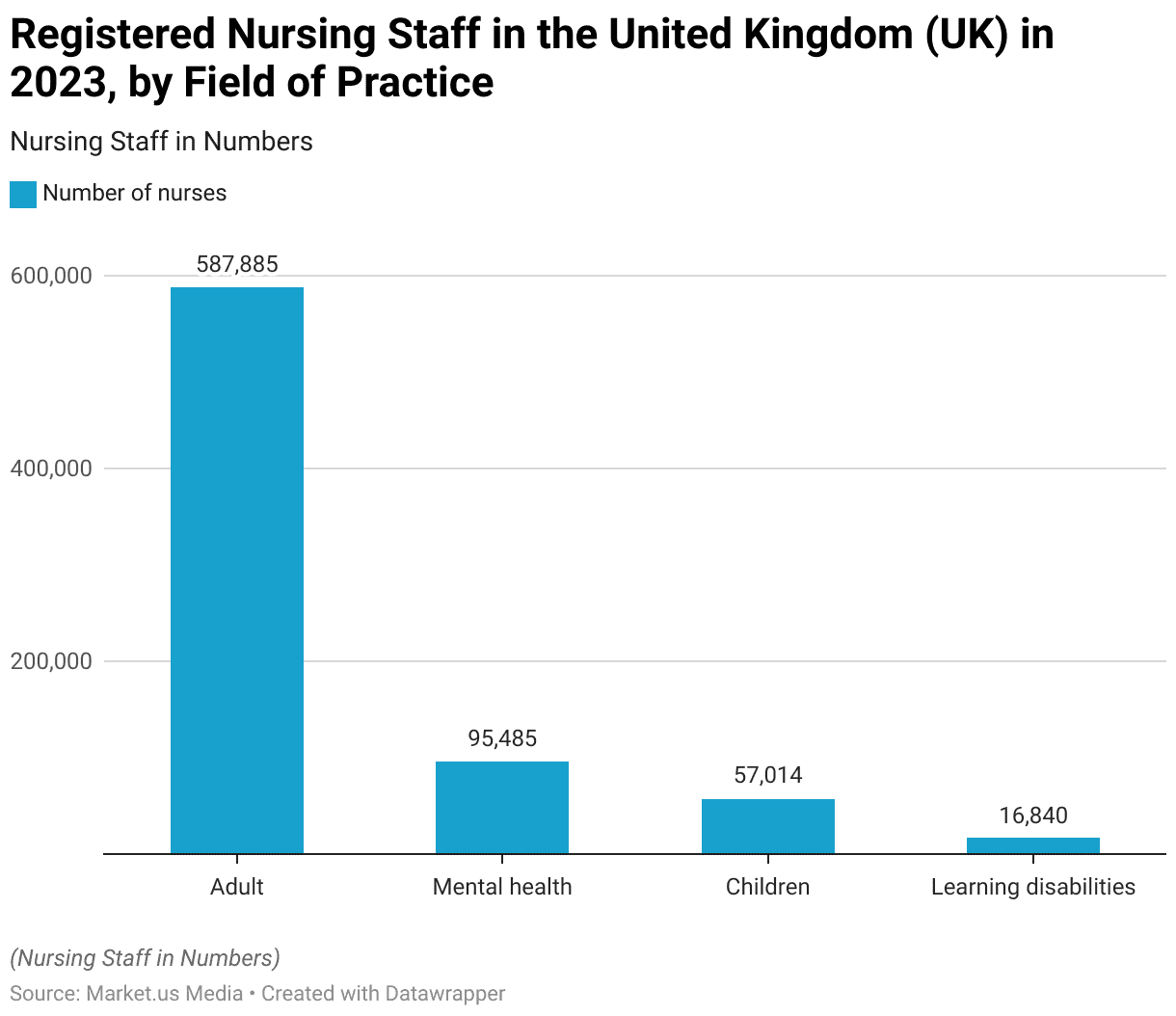
Demographic Profile of Nurses
Age Distribution
- The age distribution of the nursing workforce shows notable variations across different Human Development Index (HDI) categories.
- In countries with a Very High HDI, only 0.45% of nurses are under 25 years old. While 23.84% are aged 25-34, 23.16% are 35-44, 21.47% are 45-54, 21.36% are 55-64, and 9.72% are over 64.
- In High HDI countries, the distribution shifts slightly with 2.4% of nurses under 25, 26.36% aged 25-34, 30.03% aged 35-44, 22.7% aged 45-54, 12.97% aged 55-64, and 5.54% over 64.
- Medium HDI countries have 3.68% of nurses under 25, a higher proportion of 37.7% aged 25-34, 28.38% aged 35-44, 17.69% aged 45-54, 10.25% aged 55-64, and only 2.3% over 64.
- In Low HDI countries, 2.98% of the nursing workforce is under 25, 27.05% are aged 25-34, 34.81% are 35-44, 23.79% are 45-54, 8.95% are 55-64, and 2.42% are over 64.
- These distributions indicate a younger nursing workforce in medium and low HDI countries than in very high and high HDI countries. Where there is a more significant representation of older age groups.
(Source: PubMed)
Take advantage of our unbeatable offer - buy now!

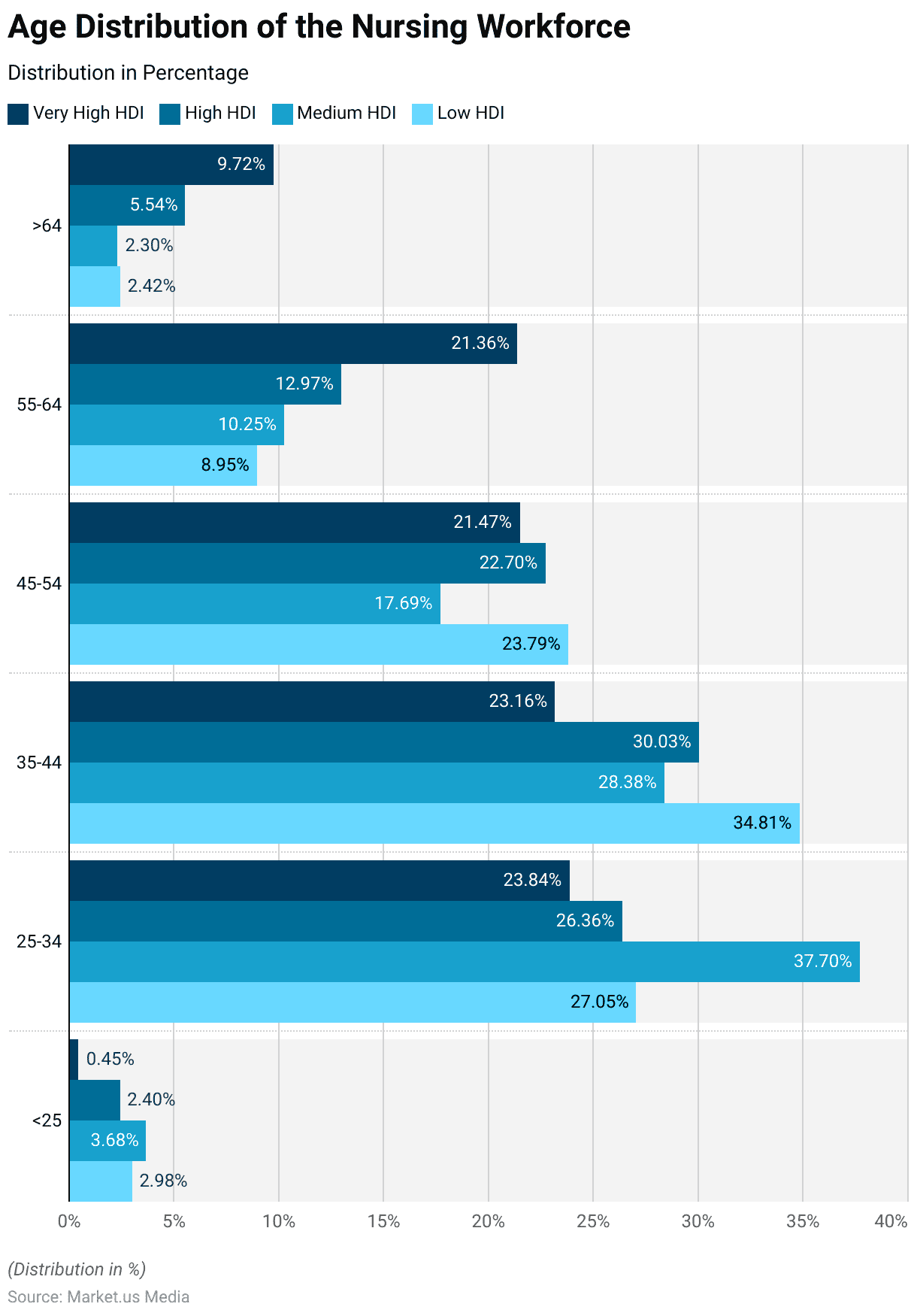
Gender Distribution
- From 2000 to 2018, the gender distribution of nurses worldwide reveals significant regional differences.
- In the African region, 65% of nurses are female and 35% are male.
- The Region of the Americas has the highest percentage of female nurses at 86%, with males comprising 14%.
- In the Eastern Mediterranean region, the distribution is 79% female and 21% male.
- The European region sees 84% of its nursing workforce as female, with 16% being male.
- Similarly, in the Southeast Asia region, 79% of nurses are female and 21% are male.
- Lastly, the Western Pacific region has 81% female nurses and 19% male nurses.
- These statistics indicate a predominantly female nursing workforce across all regions. With the highest gender disparity observed in the Region of the Americas.
(Source: Statista)

Ethnic and Racial Diversity
Registered Nurses
- The racial and ethnic distribution of registered nurses in the United States shows a significant majority of White nurses, who comprise 75.4% of the workforce.
- Black or African American nurses make up 23.6%, while Hispanic nurses account for 7.5%.
- Asian nurses represent 3.6% of the nursing population.
- Those identifying as two or more races constitute 1.4%, and American Indian or Alaskan Native nurses make up 0.6% of the total.
- This data highlights the diversity within the U.S. nursing workforce, although it is predominantly composed of White individuals.
(Source: Data/Statistics, The Office of Minority Health, U.S. Department of Health and Human Services)
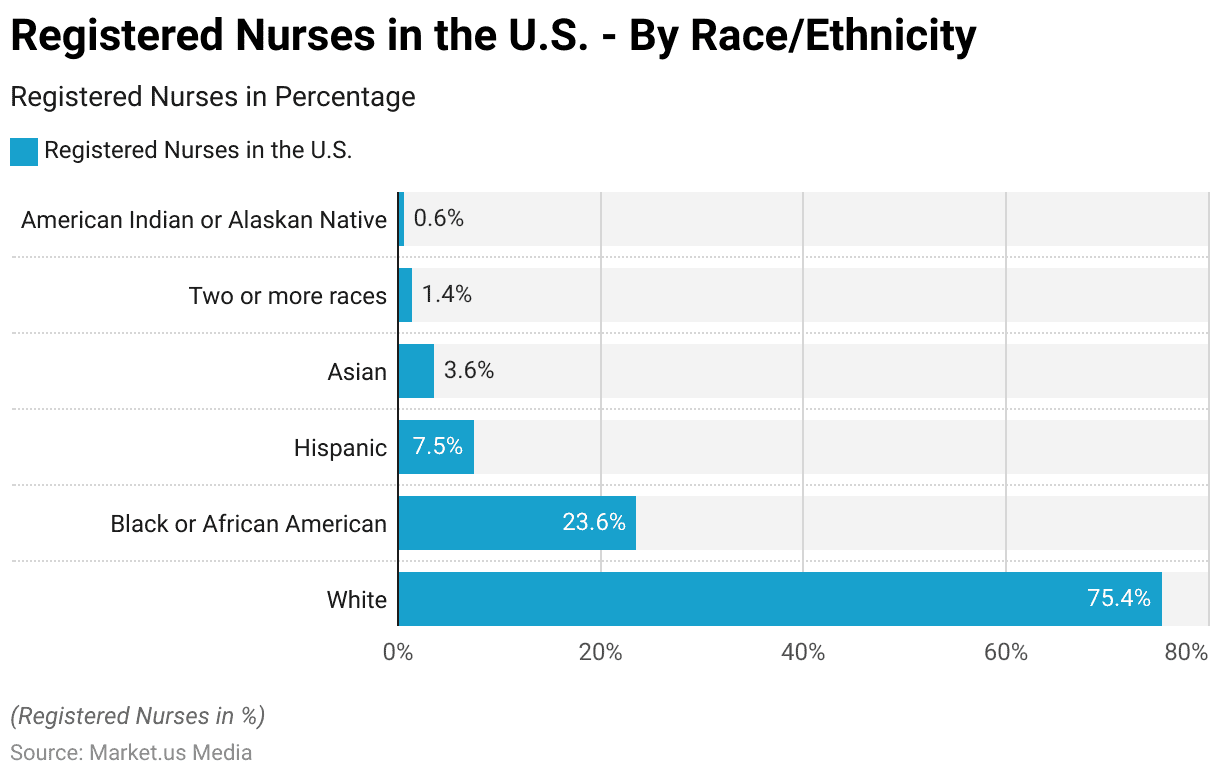
Nursing Assistants
- As of 2021, the distribution of nursing assistants in U.S. nursing homes by ethnicity reveals a diverse workforce.
- White nursing assistants constitute 44% of the total, while Black or African American nursing assistants make up 35%.
- Hispanic or Latino individuals of any race account for 12% of nursing assistants.
- Asian or Pacific Islander nursing assistants represent 4% of the workforce, and those classified as Other comprise 5%.
- This data underscores the ethnic diversity present among nursing assistants in U.S. nursing homes.
(Source: Statista)
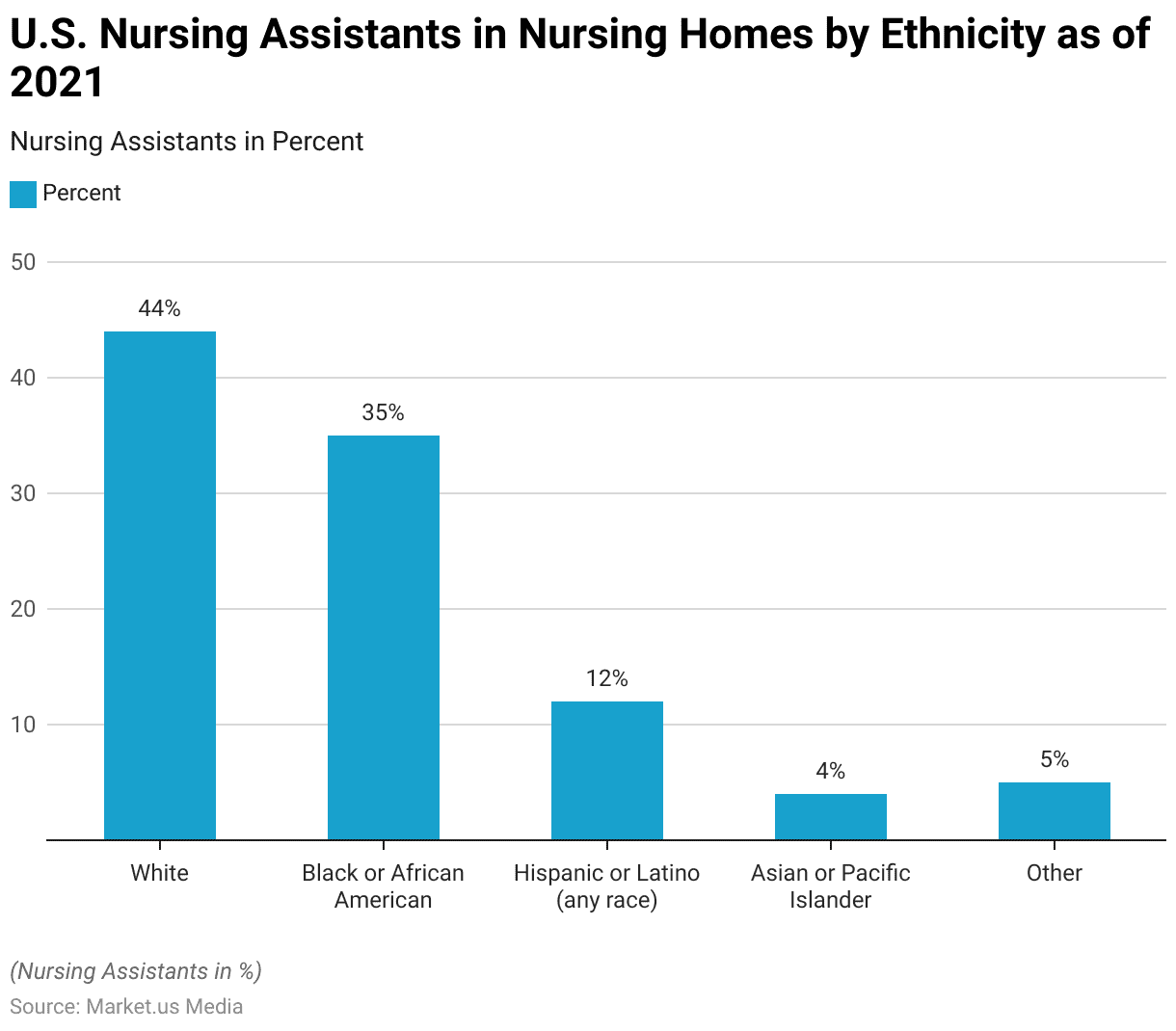
Nursing Work Shifts Statistics
Nursing Shift Length – By Care Setting
- The distribution of nursing shift lengths across various care settings. Categorized by age group, highlights significant trends among different age cohorts.
- Among nurses under 25 years old, 8% work in inpatient settings. 7% in emergency departments, 2% in ambulatory care, and 7% in long-term care.
- Nurses aged 25-34 predominantly work in inpatient (34%) and emergency department (36%) settings, with 18% in ambulatory care and 28% in long-term care.
- Those aged 35-44 show a more balanced distribution: 22% in inpatient. 28% in emergency departments, 20% in ambulatory care, and 26% in long-term care.
- Nurses aged 45-54 are primarily found in ambulatory care (25%). With 21% in inpatient settings, 20% in emergency departments, and 19% in long-term care.
- The 55-64 age group has the highest representation in ambulatory care (32%). Followed by inpatient (14%), emergency departments (9%), and long-term care (17%).
- Nurses aged 65 and older are the least represented across all settings. With 1% in inpatient, 4% in ambulatory care, and 2% in long-term care.
- This data indicates a trend where younger nurses are more likely to work in high-intensity settings like inpatient and emergency departments. In comparison, older nurses tend to prefer ambulatory and long-term care settings.
(Source: Mckinsey)
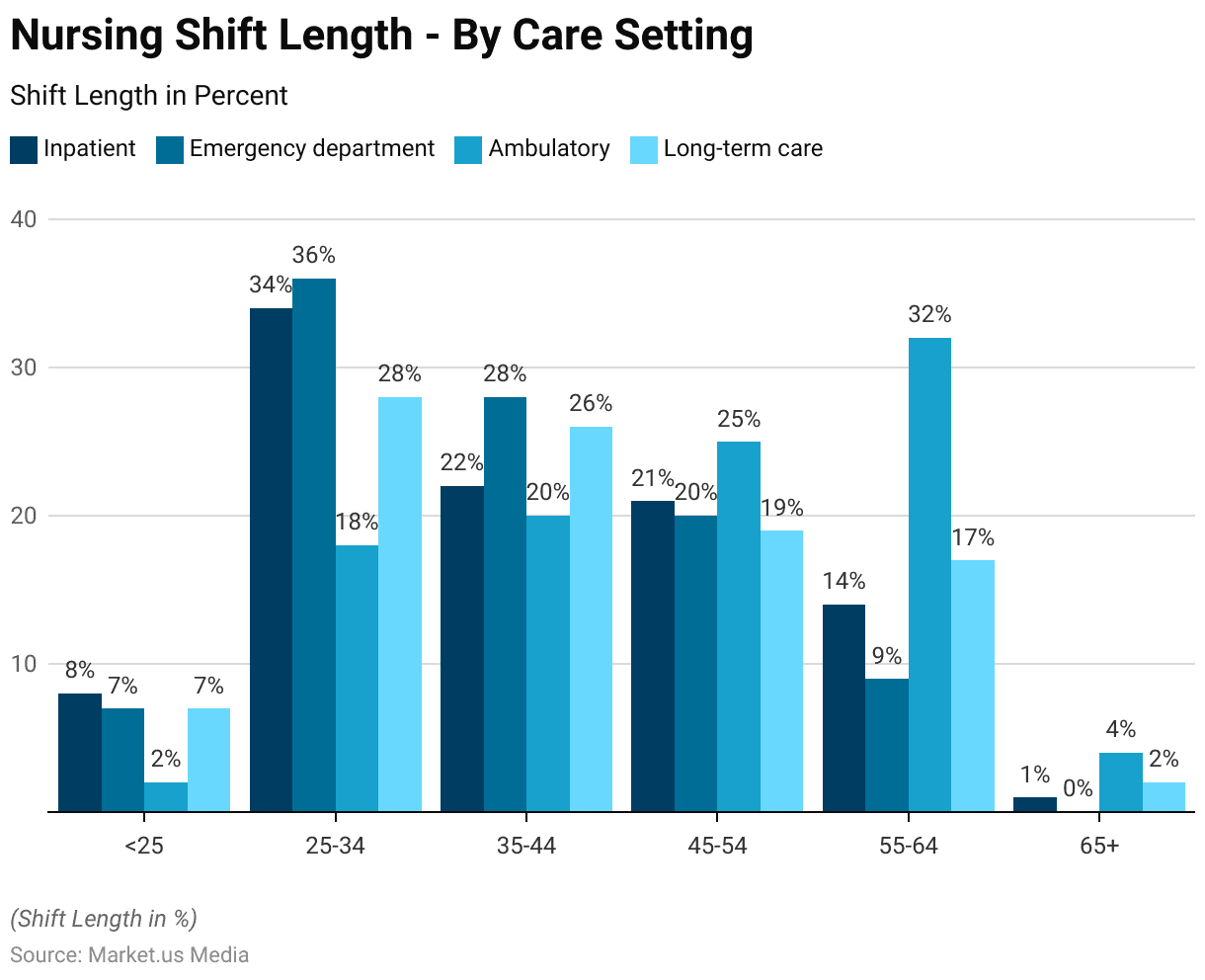
Nursing Shift Length – By Care Setting: According to Working Hours
- The distribution of nursing shift lengths across various care settings indicates significant variation in working hours.
- Among inpatient nurses, 17% work shifts of 12 or more hours, 51% work 12-hour shifts, 12% work 10-hour shifts, 19% work 8-hour shifts, and 1% work less than 8-hour shifts. With another 1% falling into the ‘Other’ category.
- In the emergency department, the majority of nurses (67%) work 12-hour shifts. Followed by 19% working 12+ hour shifts, 9% working 8-hour shifts, and 6% working 10-hour shifts. With no respondents working less than 8 hours or in the ‘Other’ category.
- Ambulatory care nurses have a different pattern, with 54% working 8-hour shifts, 19% working 10-hour shifts, 16% working less than 8 hours, 7% working 12-hour shifts, 4% working 12+ hour shifts, and 1% in the ‘Other’ category.
- In long-term care, 55% of nurses work 8-hour shifts, 20% work 12-hour shifts, 12% work 10-hour shifts, 10% work 12+ hour shifts, 2% work less than 8 hours, and 2% fall into the ‘Other’ category.
- This data highlights that 12-hour shifts are predominant in inpatient and emergency settings. While 8-hour shifts are more common in ambulatory and long-term care settings.
(Source: Mckinsey)

Education Level of Nursing Workforce Statistics
Highest Level of Nursing Education Attained – By Care Level
- The highest level of nursing education attained by nurses varies significantly across different care settings.
- In inpatient care, 3% of nurses hold a diploma, 25% have an associate’s degree, and 53% possess a bachelor’s degree. 15% have a master’s degree, 2% hold a doctoral degree, and another 2% fall into the ‘Other’ category.
- In the emergency department, 1% of nurses have a diploma, 28% hold an associate’s degree, and 57% have a bachelor’s degree. 11% possess a master’s degree, and 2% are categorized as ‘Other,’ with no respondents holding a doctoral degree.
- For ambulatory care nurses, 5% have a diploma, 24% hold an associate’s degree, 45% have a bachelor’s degree, 22% possess a master’s degree, 2% hold a doctoral degree, and 2% are classified as ‘Other.’
- In long-term care settings, 8% of nurses have a diploma, 49% hold an associate’s degree, 30% possess a bachelor’s degree, 10% have a master’s degree, 1% hold a doctoral degree, and 2% fall into the ‘Other’ category.
- This data indicates that bachelor’s degrees are most prevalent among inpatient and emergency department nurses. While associate’s degrees are more common in long-term care settings. Master’s degrees are notably higher in ambulatory care compared to other settings.
(Source: Mckinsey)

Education Level of Nursing Assistants in Nursing Homes
- As of 2021, the education level distribution of nursing assistants in U.S. nursing homes reveals a diverse range of educational backgrounds.
- 11% of nursing assistants have less than a high school education.
- The largest group, comprising 43%, are high school graduates.
- Those with some college education but no degree make up 32% of the workforce.
- Meanwhile, 14% of nursing assistants hold an associate’s degree or higher.
- This data highlights that while a significant portion of nursing assistants have pursued post-secondary education. The majority have attained a high school diploma or some college experience without completing a degree.
(Source: Statista)
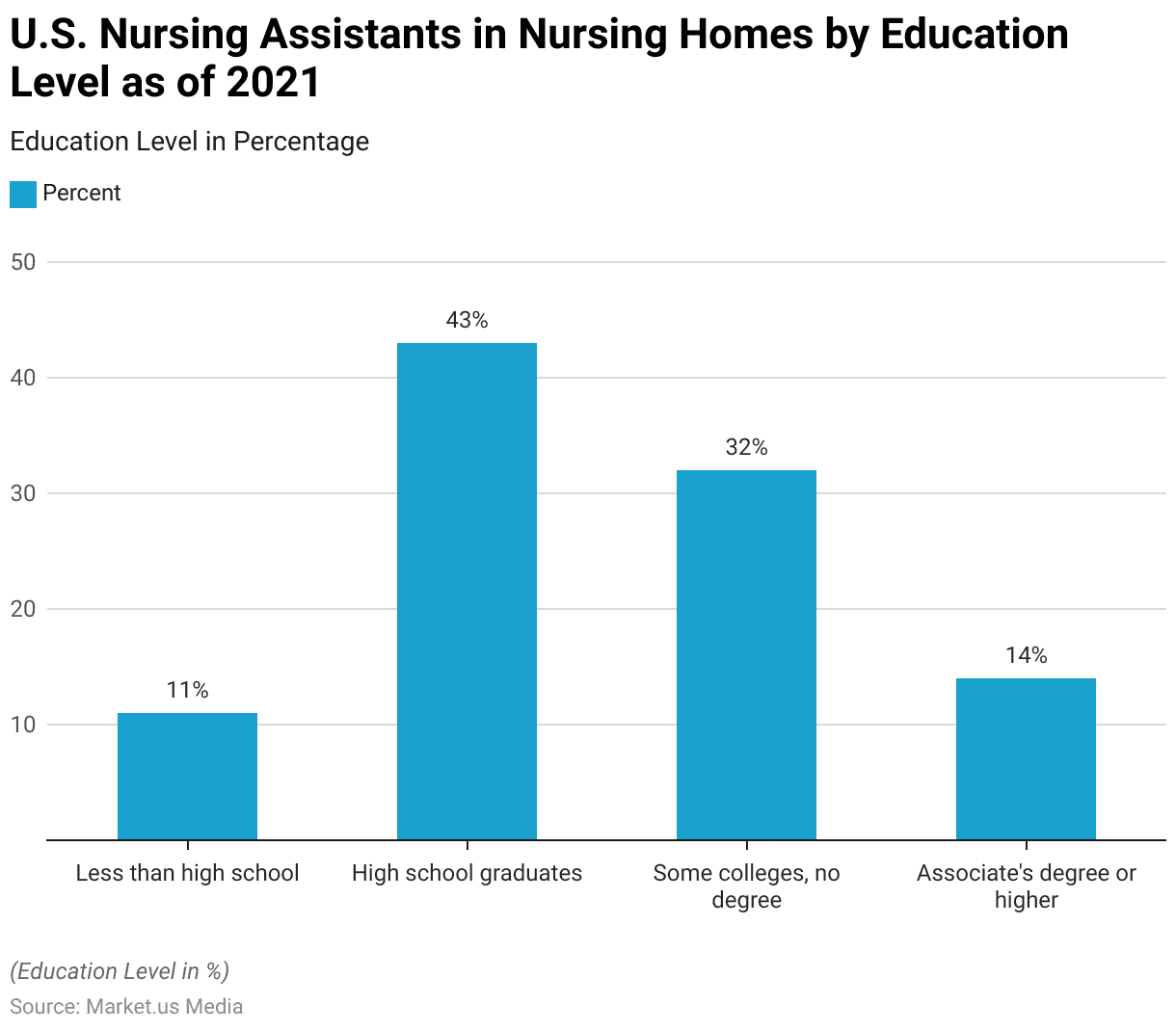
Nursing Workforce Salaries Statistics
Highest Paying Countries for Nurses
- The highest paying countries for nurses, based on average annual salary in USD, reveal a range of lucrative opportunities across various regions.
- Luxembourg leads with an average salary of $97,857 per year, followed closely by Switzerland at $93,971 and Denmark at $89,419.
- Nurses in the United Arab Emirates earn an average of $86,759 annually, while those in Australia receive $79,550.
- In the United States, the average salary for nurses is $75,387 per year.
- The Netherlands offers an average annual salary of $73,029, slightly higher than Canada’s $72,729.
- Nurses in Norway earn an average of $71,848 per year and in Germany. The average annual salary is $69,981.
- This data highlights that European and North American countries. Along with the UAE and Australia, offer some of the highest compensation levels for nurses globally.
(Source: Economic Research Institute)
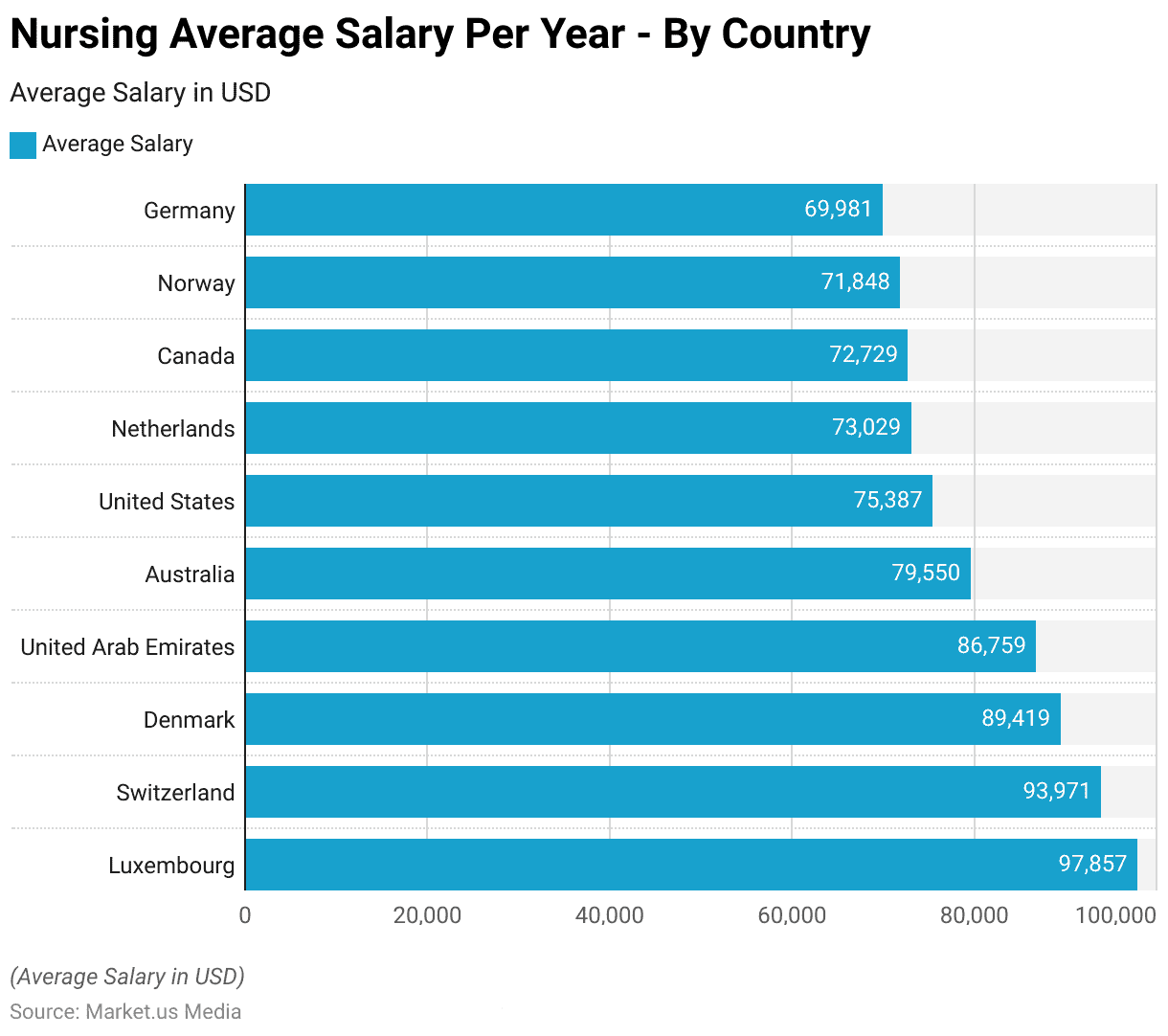
Salary of Registered Nurses (RNs and APRNs)
- As of June 2017, the average salary of U.S. registered nurses and advanced practice registered nurses varied significantly by region.
- In the Pacific region, nurses earned the highest average salary at $97,708 per year.
- New England followed with an average salary of $76,566, closely trailed by the Middle Atlantic region at $76,086.
- In the Mountain region, nurses receive an average of $75,339 annually.
- The West South Central region offered an average salary of $71,649. While the East North Central region had an average of $67,911.
- Nurses in the South Atlantic and East South Central regions earned $66,435 and $64,050, respectively.
- The West North Central region had the lowest average salary at $62,634 per year.
- This data highlights regional disparities in nursing salaries across the United States, with the Pacific region offering the highest compensation.
(Source: Statista)
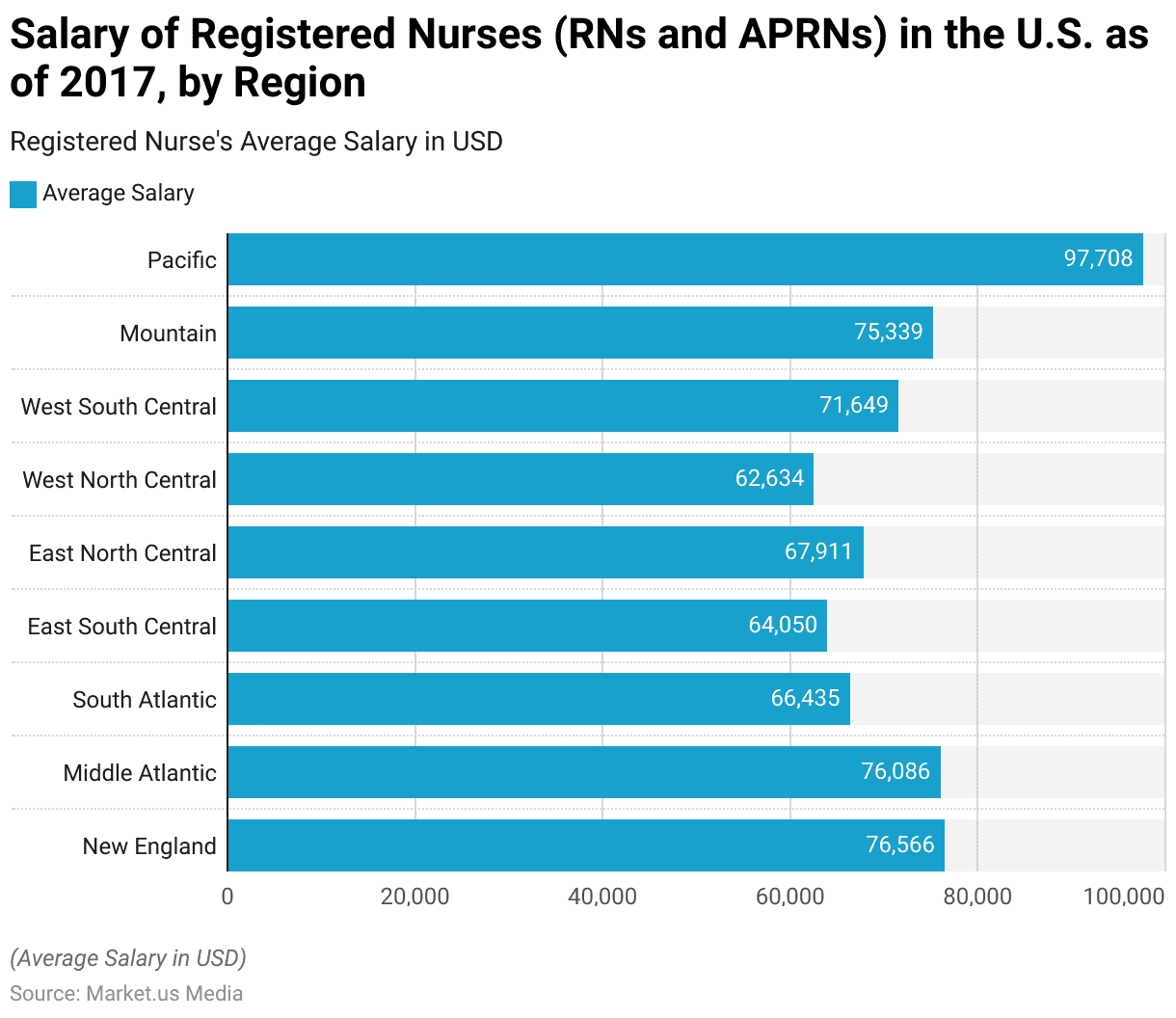
Nursing Workforce Pay Gap Statistics
Salary Gap Between Male and Female Nurses – By Work Setting
- The salary gap between male and female nurses varies by work setting in the U.S., reflecting significant disparities in 2013.
- In ambulatory care settings, male nurses earn, on average, $7,678 more than their female counterparts.
- In hospital settings, the salary gap is somewhat smaller, with male nurses earning $3,873 more than female nurses.
- These figures highlight ongoing gender-based pay disparities within the nursing profession, with a notably larger gap in ambulatory care compared to hospital environments.
(Source: Statista)
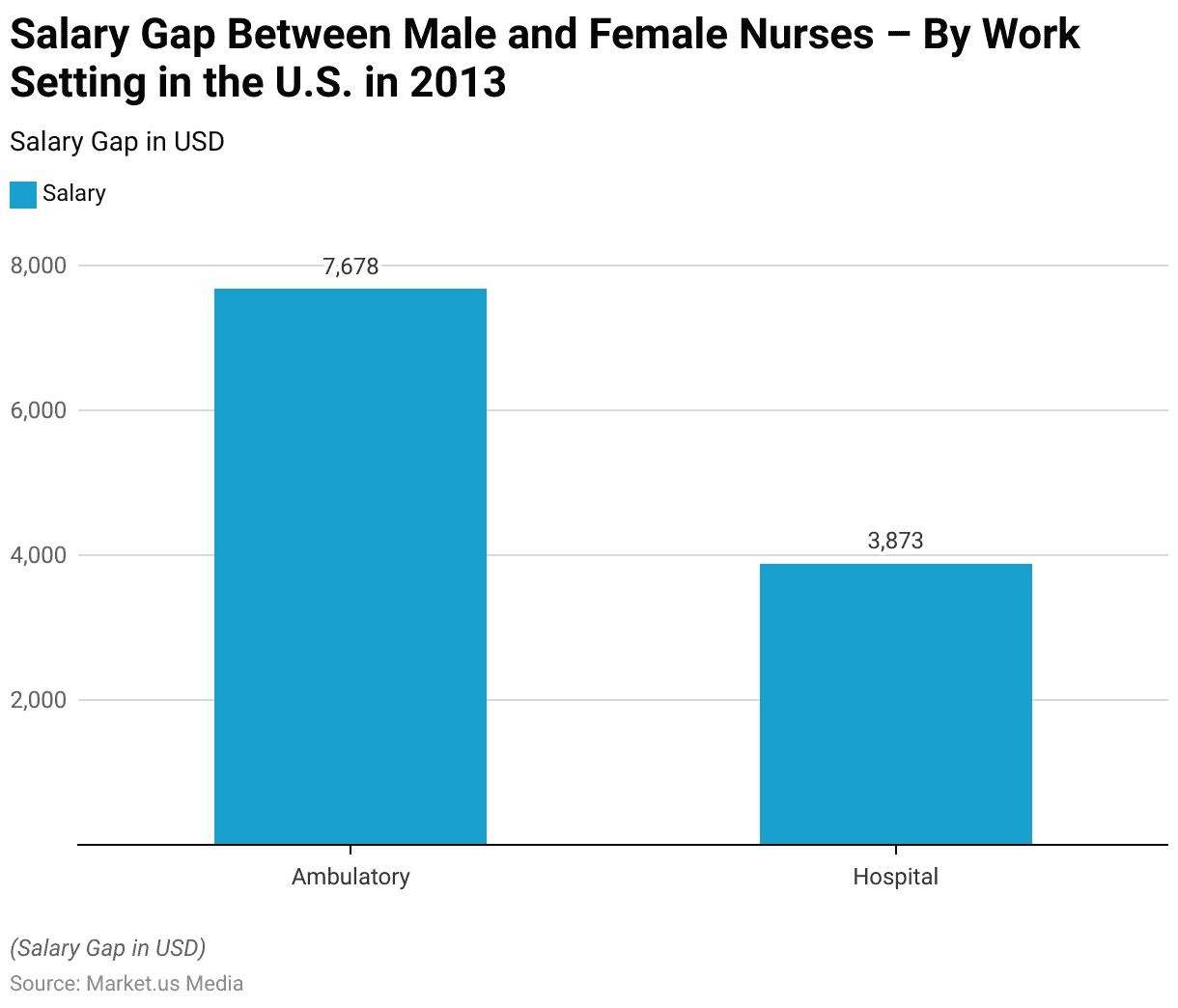
Salary Gap Between Male and Female Nurses – By Clinical Specialty
- In 2013, the salary gap between male and female nurses in the U.S. varied across different clinical specialties, indicating significant disparities.
- In cardiology, male nurses earned $6,034 more than their female counterparts.
- The gap in the medical/surgical specialty was $5,280, while in neurology, it was $5,146.
- Psychiatry saw a gap of $5,058, and in newborn/pediatrics, the difference was $3,807.
- Chronic care reported a salary gap of $3,792, while orthopedics had the smallest gap at $2,086.
- These figures reveal that gender-based pay disparities persist across various nursing specialties. With the most pronounced differences in cardiology and medical/surgical fields.
(Source: Statista)
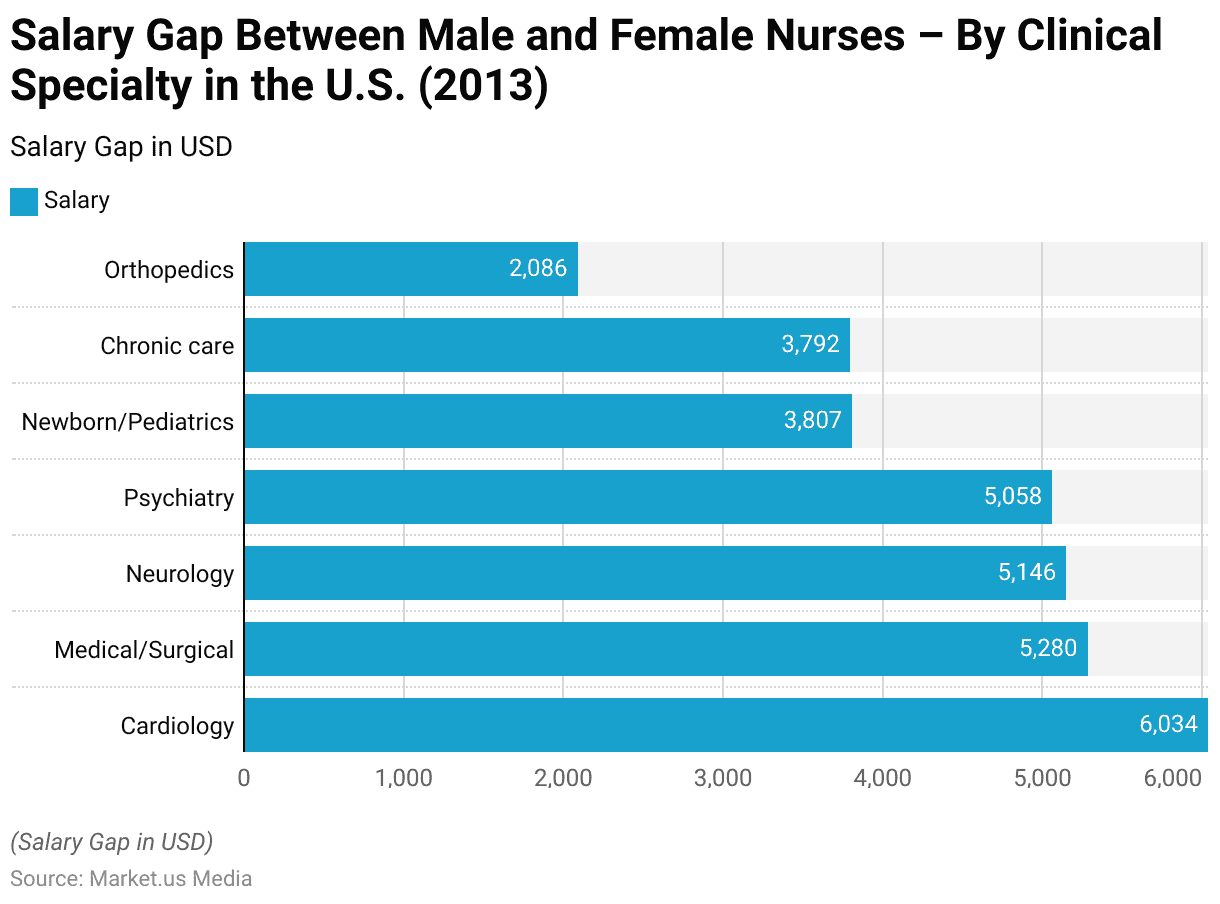
Salary Gap Between Male and Female Nurses – By Job Position
- In 2013, the salary gap between male and female nurses in the U.S. varied significantly by job position, revealing notable disparities.
- Nurse anesthetists experienced the largest gap, with male nurses earning $17,290 more than their female counterparts.
- Middle management positions saw a gap of $6,918, while senior administrators had a difference of $5,839.
- In advanced practice roles, the salary gap was $5,787, and in education/research positions, it was $5,308.
- Staff nurses faced a gap of $5,277, and those in advanced clinical roles had a gap of $4,328.
- These figures underscore substantial gender-based pay differences across various nursing job positions. With the most significant gap observed among nurse anesthetists.
(Source: Statista)
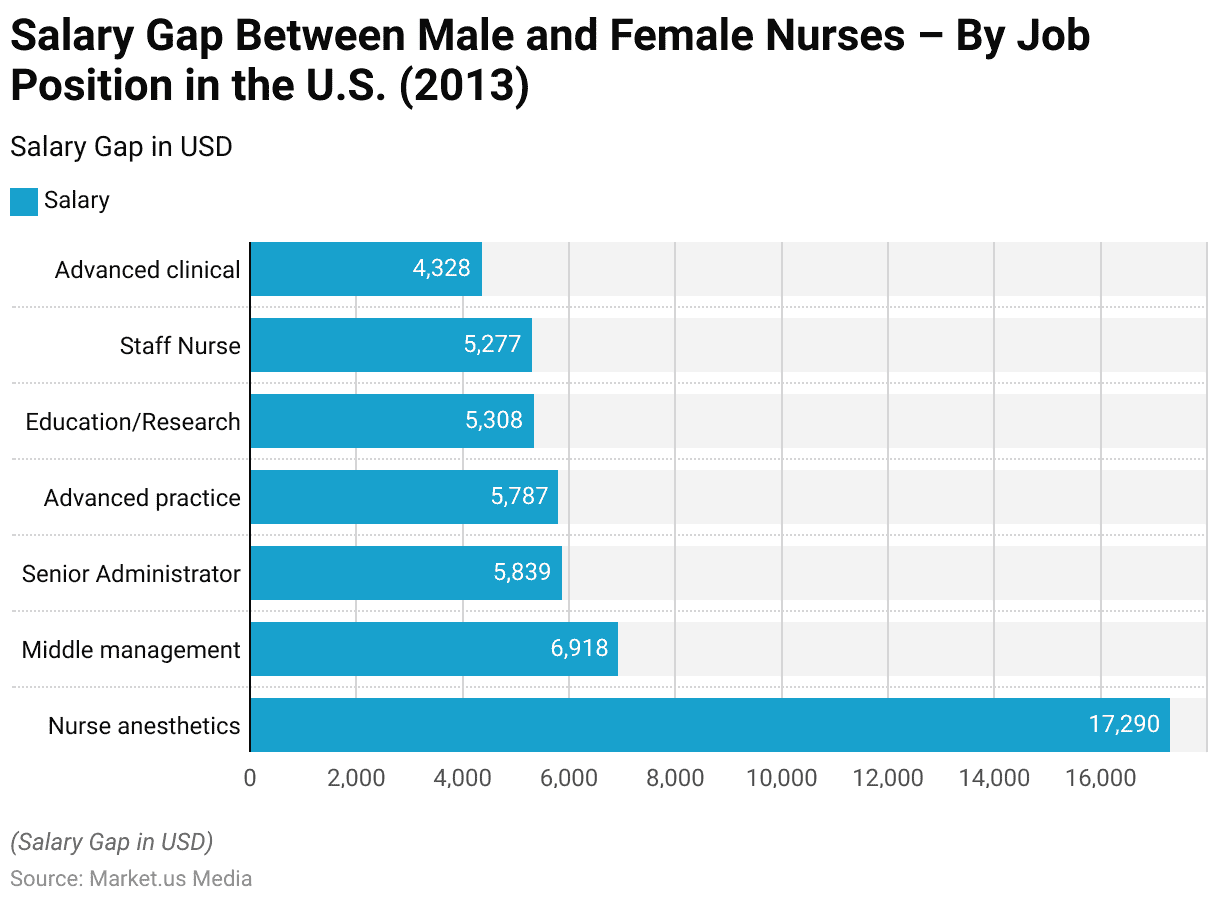
Private Nursing Workforce Industry Statistics
Global Private Nursing Workforce Services Market Size Statistics
- The global private nursing services market has demonstrated a consistent growth trajectory from 2022 to 2032 at a CAGR of 7%.
- In 2022, the market revenue was $609.7 billion, which increased to $652.4 billion in 2023.
- This upward trend continued, with the market reaching $692.1 billion in 2024 and $753.3 billion in 2025.
- By 2026, the revenue grew to $812.9 billion, and in 2027, it further climbed to $862.5 billion.
- The market maintained its growth, hitting $899.6 billion in 2028 and $962.6 billion in 2029.
- By 2030, the market revenue crossed the trillion-dollar mark, reaching $1,021.3 billion, and continued to grow to $1,092.8 billion in 2031.
- The forecast for 2032 predicts the market will achieve $1,179.3 billion. Reflecting a significant and steady increase over the decade.
(Source: market.us)

Global Private Nursing Workforce Services Market Size – By Application Statistics
2022-2027
- The global private nursing services market has seen substantial growth from 2022 to 2027, with revenues expanding across various applications.
- In 2022, the total market revenue was $609.7 billion, with children’s services accounting for $239.0 billion, adult services generating $182.9 billion, special groups contributing $115.8 billion, and other applications bringing in $71.9 billion.
- By 2023, the market grew to $652.4 billion, with revenues from children’s services rising to $255.7 billion, adult services to $195.7 billion, special groups to $124.0 billion, and other applications to $77.0 billion.
- This upward trend continued into 2024, where the total market reached $692.1 billion, with children’s services at $271.3 billion, adult services at $207.6 billion, special groups at $131.5 billion, and other applications at $81.7 billion.
- The market further expanded in 2025 to $753.3 billion, driven by $295.3 billion from children’s services, $226.0 billion from adult services, $143.1 billion from special groups, and $88.9 billion from other applications.
- In 2026, the market size increased to $812.9 billion, with children’s services contributing $318.7 billion, adult services $243.9 billion, special groups $154.5 billion, and other applications $95.9 billion.
- By 2027, the market revenue reached $862.5 billion, with $338.1 billion from children’s services, $258.8 billion from adult services, $163.9 billion from special groups, and $101.8 billion from other applications.

2028-2032
- The market continued its growth trajectory, reaching $899.6 billion in 2028, with children’s services generating $352.6 billion, adult services $269.9 billion, special groups $170.9 billion, and other applications $106.2 billion.
- In 2029, the total market revenue rose to $962.6 billion, with children’s services at $377.3 billion, adult services at $288.8 billion, special groups at $182.9 billion, and other applications at $113.6 billion.
- By 2030, the market had crossed the trillion-dollar mark, totaling $1,021.3 billion, with children’s services contributing $400.3 billion, adult services $306.4 billion, special groups $194.0 billion, and other applications $120.5 billion.
- In 2031, the market grew to $1,092.8 billion, driven by $428.4 billion from children’s services, $327.8 billion from adult services, $207.6 billion from special groups, and $129.0 billion from other applications.
- Finally, in 2032, the market reached $1,179.3 billion, with children’s services at $462.3 billion, adult services at $353.8 billion, special groups at $224.1 billion, and other applications at $139.2 billion. This decade-long growth highlights the increasing demand and expanding scope of private nursing services worldwide.
(Source: market.us)
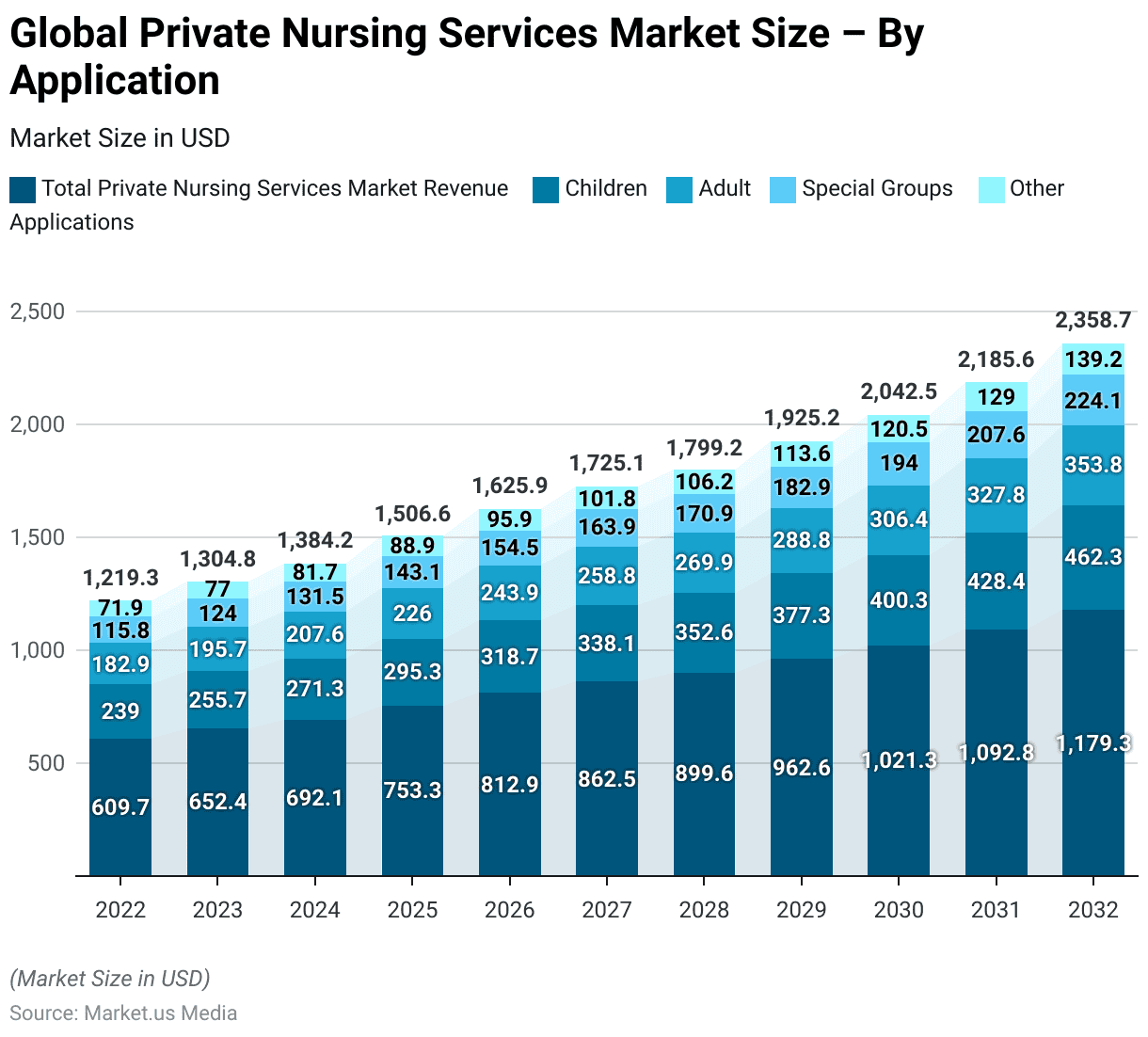
Global Private Nursing Workforce Services Market Share – By Gender Statistics
- The global private nursing services market exhibits a distinct gender distribution in market share.
- As of the latest data, female nurses dominate the market, holding a 65% share, while male nurses account for the remaining 35%.
- This significant gender disparity underscores the predominantly female composition of the nursing workforce in the private sector worldwide.
(Source: market.us)

Nursing Workforce Care Spending Statistics
2013-2017
- From 2013 to 2021, spending on nursing care in the United States exhibited significant changes across different payer categories.
- In 2013, private health insurance contributed $12.6 billion, while out-of-pocket spending was the highest at $45.8 billion. Other payers accounted for $11.5 billion, Medicare contributed $34.6 billion, Medicaid provided $46.9 billion, and other public health insurance accounted for $4.5 billion.
- By 2014, private health insurance spending had increased to $13.1 billion, while out-of-pocket spending decreased to $41.2 billion. Other payers contributed $11.3 billion, Medicare $35.7 billion, Medicaid $49.6 billion, and other public health insurance $4.7 billion.
- In 2015, private health insurance spending rose to $13.4 billion, with out-of-pocket spending at $40.1 billion, other payers at $11 billion, Medicare at $37.6 billion, Medicaid at $49.7 billion, and other public health insurance at $5 billion.
- The trend continued in 2016, with private health insurance spending increasing to $14.8 billion, out-of-pocket spending at $43.8 billion, other payers at $11.6 billion, Medicare at $37.5 billion, Medicaid at $50 billion, and other public health insurance at $5.1 billion.
- In 2017, private health insurance spending reached $16.6 billion, out-of-pocket spending $44.3 billion, other payers $12.1 billion, Medicare $37.7 billion, Medicaid $50.2 billion, and other public health insurance $5.4 billion.
2018-2021
- By 2018, private health insurance spending had risen to $17.1 billion, out-of-pocket spending to $44.8 billion, other payers to $12.9 billion, Medicare to $38.1 billion, Medicaid to $49.9 billion, and other public health insurance to $5.7 billion.
- In 2019, private health insurance spending increased to $18 billion, out-of-pocket spending to $45.6 billion, other payers to $14.1 billion, Medicare to $38.2 billion, Medicaid to $50.8 billion, and other public health insurance to $6 billion.
- In 2020, private health insurance spending decreased to $16.7 billion, while out-of-pocket spending remained at $45.6 billion. Other payers saw a significant increase to $35.5 billion, Medicare spending rose to $39.6 billion, Medicaid to $53.2 billion, and other public health insurance to $6.5 billion.
- By 2021, private health insurance spending was $16.3 billion, out-of-pocket spending $44.4 billion, other payers $19 billion, Medicare $40.6 billion, Medicaid $54.3 billion, and other public health insurance $6.8 billion.
- This period reflects notable shifts in the funding sources for nursing care in the U.S., with substantial increases in Medicaid and other payer contributions, particularly in 2020.
(Source: Statista)

Key Nursing Workers’ Issues and Industry Trends
Level of Stress Experienced by Registered Nurses During Their Work
- In 2023, registered nurses in the United States reported high levels of stress during their work.
- A significant 56% of respondents indicated experiencing a great deal of stress.
- Additionally, 25% reported feeling a lot of stress, while 15% experienced a moderate amount.
- Only a small proportion of nurses reported lower stress levels, with 3% indicating little stress and just 1% stating they did not feel stressed at all.
- This data underscores the substantial stress burden faced by the nursing workforce in the U.S.
(Source: Statista)
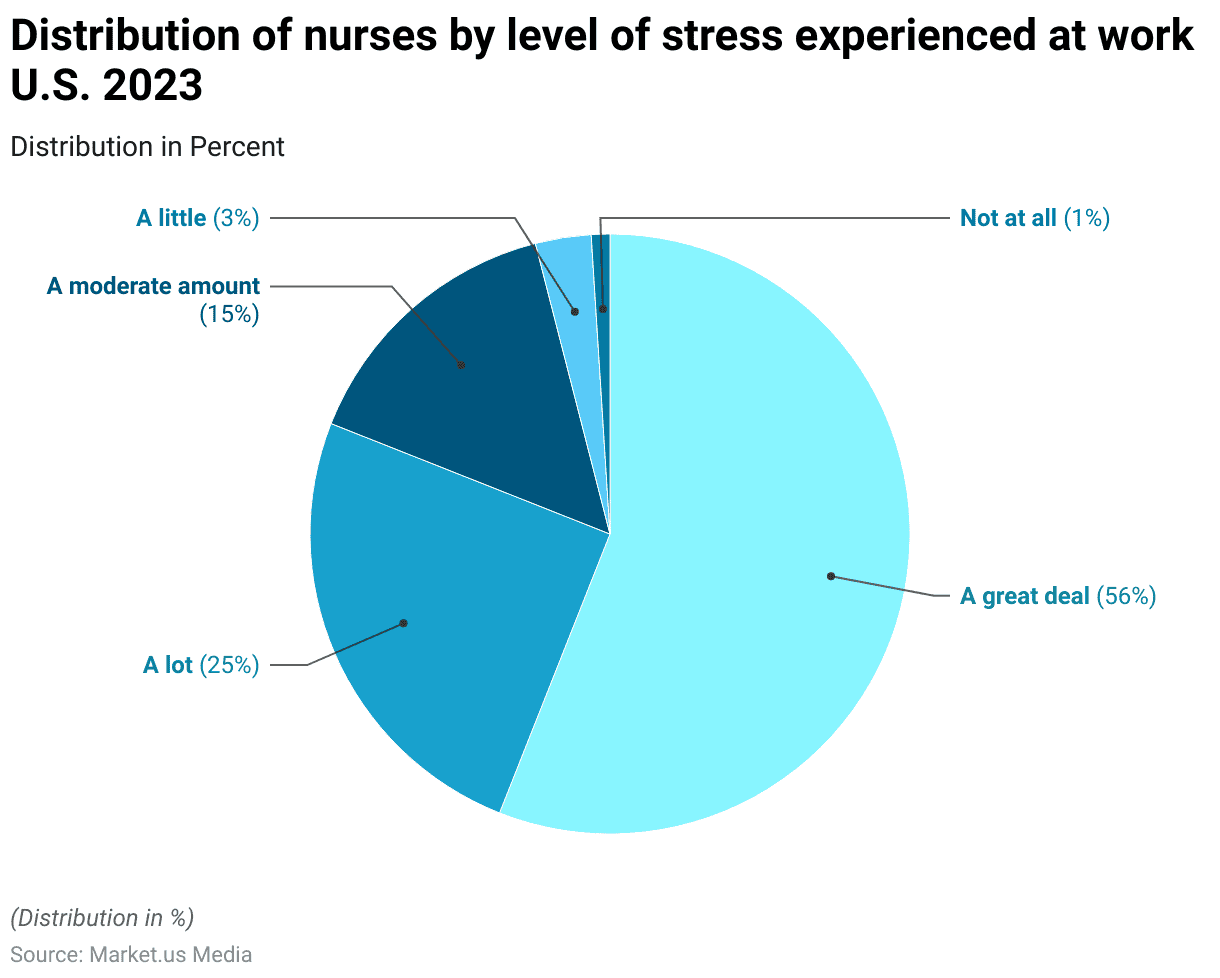
Factors Influencing Decision to Leave Current Position by Nursing Workforce Statistics
- The decision of nursing workers to leave their current positions is influenced by a variety of factors. With a significant number of respondents identifying specific issues as important.
- Insufficient staffing levels were deemed important by 59% of respondents. Followed by the demanding nature and intensity of the workload, which 56% found critical.
- The emotional toll of the job was cited as important by 54%, while 51% felt that not being listened to or supported at work was a key factor.
- The physical toll of the job was considered important by 50% of respondents, and 46% highlighted family needs and competing life demands as influential.
- Seeking a higher-paid promotion was important to 43% of respondents, and 42% cited insufficient personal protective equipment as a significant factor.
- Retirement was important for 38%, and 37% were concerned about too much uncertainty or lack of control. Additionally, 30% pointed to a lack of respect from some patients or their families, and 26% felt unprepared or insufficiently trained.
- Fear of COVID-19 infection for themselves or their families was important for 23% of respondents. While 21% did not see an appealing professional development pathway.
- Conversely, some factors were viewed as neutral by many respondents. These include the uncertainty or lack of control (52%), and the lack of respect from patients or their families (53%). The need for better professional development pathways (57%), and feeling unprepared or insufficiently trained (46%).
- This data highlights the multifaceted challenges faced by nursing workers, with staffing levels, workload intensity, emotional and physical tolls, and support at work being among the most critical factors influencing their decision to leave their current positions.
(Source: Mckinsey)
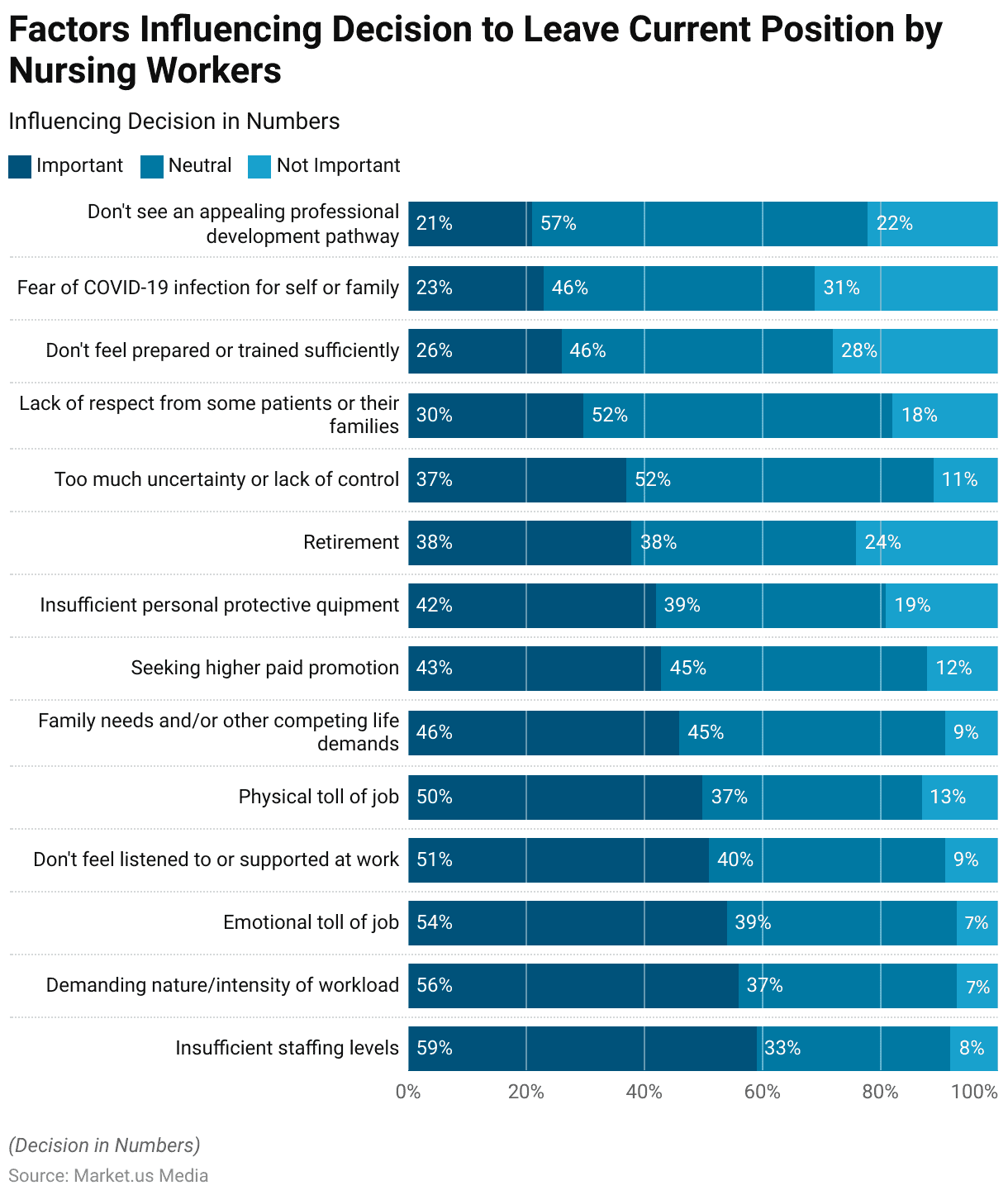
Factors Influencing Work Satisfaction Among Nursing Workforce Statistics
- To increase overall work satisfaction among nursing staff, 68% of respondents indicated that increasing salary, wages, or bonuses would be most effective.
- Additionally, 59% highlighted the need for more nurses or support staff. Addressing nurses’ needs and genuinely listening to their voices was important for 31% of respondents.
- Both increasing nurse recognition and allowing adequate time for meals and breaks were cited by 19% of respondents.
- Offering flexible scheduling was preferred by 16%, while 15% emphasized the importance of being able to take a day off when necessary.
- Implementing a no-tolerance workplace policy was important for 10%, and increasing shared governance was mentioned by 9%.
- Providing more mental health and well-being services was also important for 9%, and 8% of respondents wanted the implementation of innovative technology.
- Creating an anti-bullying policy or program was suggested by 7%, while 6% had other suggestions.
- Providing more housing, transportation, or childcare services was important for 4%, and 3% wanted longer maternity and paternity leave or the opportunity to attend a formal resiliency program.
- These responses highlight the diverse factors that contribute to nursing staff work satisfaction.
(Source: American Nurses Foundation 2022 Workplace Survey)
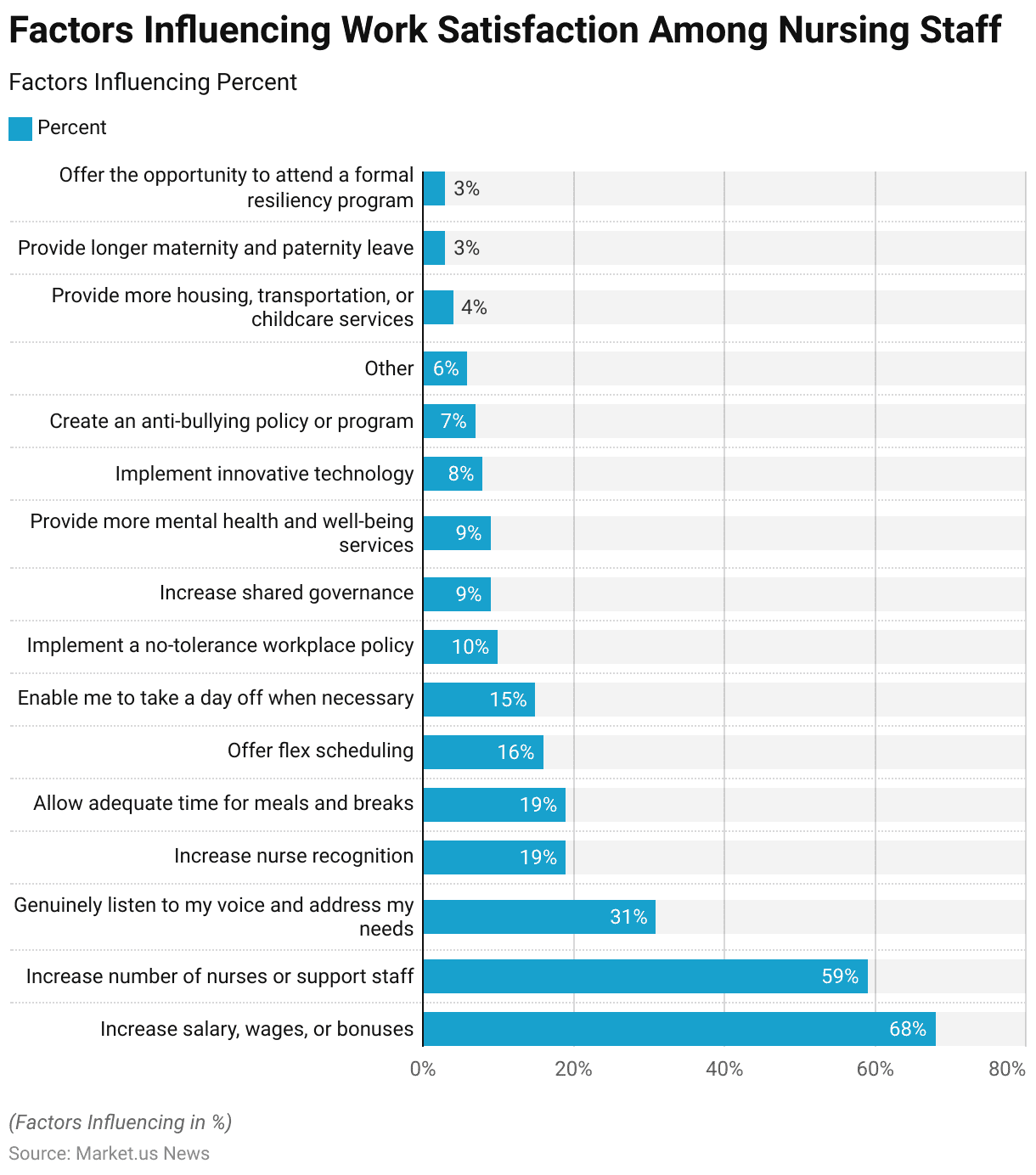
Perception of Effectiveness of Support Initiatives Among Nursing Workforce Statistics
- Nursing workers perceive various support initiatives as critical to their effectiveness and well-being.
- Among respondents, 68% rated more appropriate and sufficient recognition as important. With 28% viewing it as neutral and only 4% considering it not important.
- Open lines of communication were deemed important by 67%, neutral by 29%, and not important by 4%.
- Embedding more breaks into the operating model was considered important by 64%. Neutral by 30%, and not important by 6%.
- Active monitoring of nurse distress and proactive outreach were seen as important by 62%. Neutral by 34%, and not important by 3%.
- Increased availability and accessibility of other support resources were important to 60% of respondents, neutral to 33%, and not important to 7%.
- Evolving the culture to make discussing and seeking help a normal part of the day was important for 59%, neutral for 35%, and not important for 6%.
- Increased availability and accessibility of mental health resources were important for 54%, neutral for 40%, and not important for 6%.
- Finally, facilitating greater personal connections between nurses was important for 50%, neutral for 44%, and not important for 6%.
- These perceptions highlight the diverse range of initiatives considered essential by nursing workers to enhance their support and overall effectiveness.
(Source: Mckinsey)
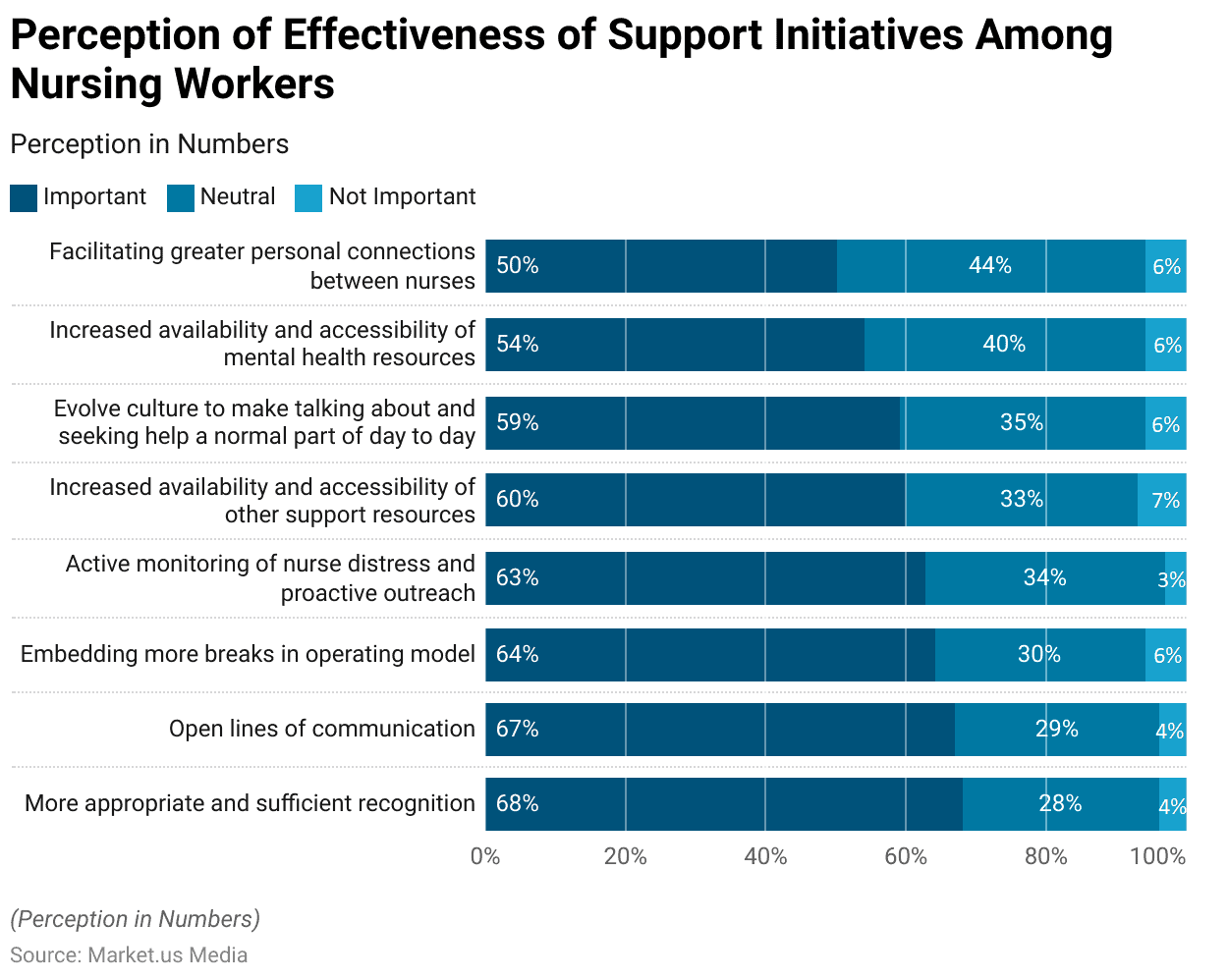
Impact of COVID-19
- Since the beginning of the COVID-19 pandemic, there has been a notable increase in nursing employment.
- Current data shows that approximately 89% of registered nurses (RNs) with active licensure are employed in nursing roles.
- Among these, 70% work full-time, 11% part-time, and around 8% on a per diem basis. This represents an increase from 84% in 2020.
- Similarly, the percentage of licensed practical nurses (LPNs) and licensed vocational nurses (LVNs) employed in nursing roles rose to 88% in 2022 from 82% in 2020.
- However, the COVID-19 pandemic might still influence future employment trends. Survey results reveal that 28% of all nurse respondents are planning to retire within the next five years, up from 21% in 2020.
- Hospitals remain the primary workplace for R.N.s, followed by ambulatory care settings, home health care, and nursing homes. For LPNs/LVNs, nursing homes and extended care settings are the leading practice environments, followed by hospitals.
- Compared to 2020, a higher proportion of both R.N.s and LPNs/LVNs now report providing direct patient care in their positions.
(Source: Journal of Nursing Regulation)
Regulations for Nursing Workforce Statistics
- Regulations for nursing workers exhibit significant variation across countries, addressing issues from licensing and practice standards to workplace protections and immigration rules.
- In the United States, state-level legislation often focuses on addressing staffing shortages and improving education funding.
- For example, Alabama‘s Preceptor Tax Incentive provides income tax credits to healthcare workers training in rural areas. At the same time, Arizona has allocated $15 million to increase nursing faculty in community colleges and universities.
- In the United Kingdom, new immigration regulations impose stringent conditions on international healthcare workers, including salary thresholds for family visas and increased visa application fees, which could adversely impact recruitment and retention in the healthcare sector.
- Additionally, the Pregnant Workers Fairness Act (PWFA) in the U.S. mandates reasonable accommodations for pregnant, postpartum, and lactating workers. At the same time, the Providing Urgent Maternal Protection (PUMP) for Nursing Mothers Act expands protections for nursing mothers at work.
- These regulations reflect a global recognition of the critical role of nurses and the necessity for supportive policies to ensure their welfare and effectiveness in the healthcare system.
(Sources: Nurse.org, American Association of Colleges of Nursing, Royal College of Nursing, National Employment Lawyers Association)
Recent Developments
Acquisitions and Mergers:
- AMN Healthcare acquires Synzi: In mid-2023, AMN Healthcare acquired Synzi, a virtual care communication platform, for $125 million. This acquisition aims to enhance AMN Healthcare’s telehealth capabilities and support the nursing workforce by providing better communication tools for remote patient care.
- Cross Country Healthcare acquires Workforce Solutions Group: Cross Country Healthcare completed its acquisition of Workforce Solutions Group for $90 million in late 2023. This merger is expected to strengthen Cross Country Healthcare’s staffing and workforce management solutions, addressing the increasing demand for nurses.
New Product Launches:
- Cerner’s Workforce Management Solution: In early 2024, Cerner launched a new workforce management solution designed to optimize nurse staffing levels, reduce burnout, and improve patient care outcomes. This system uses AI to predict staffing needs and streamline scheduling processes.
- Elsevier’s Clinical Skills Platform: Elsevier introduced a new clinical skills platform in mid-2023, offering comprehensive training and education resources for nurses. This platform aims to enhance the skills and competencies of the nursing workforce, promoting continuous professional development.
Funding:
- Trusted Health raises $149 million: In 2023, Trusted Health, a career platform for nurses, raised $149 million to expand its services and develop new tools to support nurse recruitment, retention, and career development.
- Incredible Health secures $80 million: Incredible Health, a platform that helps hospitals hire permanent nurses faster, secured $80 million in early 2024 to enhance its technology and expand its reach across the US healthcare system.
Technological Advancements:
- AI in Nurse Staffing: Advances in AI are being used to optimize nurse staffing, predict patient care needs, and reduce nurse burnout by providing data-driven insights and automating scheduling processes, leading to more efficient workforce management.
- Telehealth Integration: The integration of telehealth solutions is enhancing the nursing workforce by enabling remote patient monitoring, virtual consultations, and improved communication between nurses and patients, especially in rural and underserved areas.
Market Dynamics:
- Growth in Nursing Workforce: The global nursing workforce is projected to grow at a CAGR of 3.2% from 2023 to 2028, driven by increasing healthcare demands, an aging population, and ongoing healthcare reforms aimed at improving patient care and nurse working conditions.
- Rising Demand for Specialized Nurses: There is a significant increase in the demand for specialized nurses in areas such as critical care, oncology, and geriatrics, as healthcare systems seek to address specific patient needs and improve care outcomes.
Regulatory and Strategic Developments:
- US Healthcare Workforce Resilience Act: The US government introduced the Healthcare Workforce Resilience Act in early 2024, aiming to address the nursing shortage by providing funding for nurse education, training programs, and retention initiatives, ensuring a more robust healthcare workforce.
- EU Nursing Workforce Strategy: The European Union launched a new nursing workforce strategy in 2023 to improve nurse retention, enhance training programs, and promote cross-border mobility of healthcare professionals within member states.
Research and Development:
- Nurse Burnout Solutions: R&D efforts are focusing on developing solutions to reduce nurse burnout, such as stress management programs, better work-life balance initiatives, and supportive work environments, to improve nurse retention and job satisfaction.
- Advanced Training Programs: Researchers are developing advanced training programs that use simulation, virtual reality, and interactive learning to enhance the skills and competencies of nurses, preparing them for complex and evolving healthcare challenges.
Conclusion
Nursing Workforce Statistics – The nursing workforce data reveals significant regional disparities, with Finland, Switzerland, and Norway having the highest nurse densities per capita.
Younger nurses dominate in Medium and Low HDI countries, while Very High and High HDI countries have older nurses. The workforce is predominantly female globally, with notable racial and ethnic disparities in the U.S.
Educational attainment varies by care setting, and significant salary gaps exist between male and female nurses, especially among nurse anesthetists and in cardiology.
Key factors for improving work satisfaction include salary increases, adequate staffing, and better support. High stress levels are prevalent among U.S. nurses.
The private nursing services market is growing robustly, emphasizing the need for effective support initiatives.
Like recognition, open communication, and mental health resources. Addressing these challenges can create a more resilient and satisfied nursing workforce.
FAQs
The highest densities of practicing nurses per capita are found in Finland, Switzerland, and Norway, indicating significant regional disparities.
Younger nurses dominate in Medium and Low HDI countries, while Very High and High HDI countries have a higher proportion of older nurses.
The nursing workforce is predominantly female across all regions, with men making up a smaller proportion.
Yes, there are notable racial and ethnic disparities among registered nurses in the U.S. With a majority being White, followed by Black or African American, Hispanic, and Asian nurses.
Educational attainment varies by care setting, with higher degrees more common in ambulatory care compared to long-term care settings.
Key factors include salary increases, adequate staffing levels, and providing better support and recognition.
Effective support initiatives include more appropriate and sufficient recognition. Open communication, mental health resources, and fostering a culture where seeking help is normalized.
Discuss your needs with our analyst
Please share your requirements with more details so our analyst can check if they can solve your problem(s)



